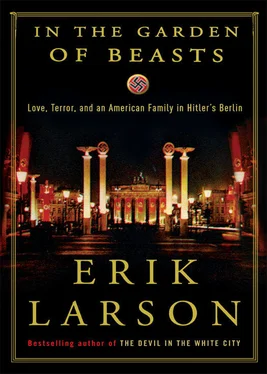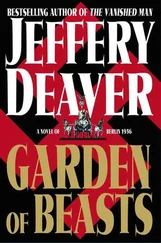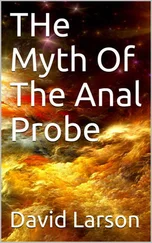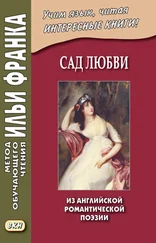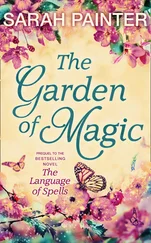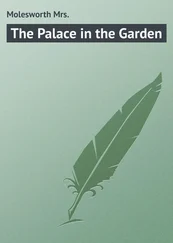A number of books that focused more closely on my particular parcel of ground proved very useful, among them Resisting Hitler: Mildred Harnack and the Red Orchestra , by Shareen Blair Brysac; The Haunted Wood , by KGB historians Allen Weinstein and Alexander Vassiliev; and Spies: The Rise and Fall of the KGB in America , by Vassiliev, John Earl Haynes, and Harvey Klehr.
Of particular, and obvious, value were Ambassador Dodd’s Diary , edited by Martha and Bill Jr., and Martha’s memoir, Through Embassy Eyes . Neither work is wholly trustworthy; both must be treated with care and used only in conjunction with other, corroborative sources. Martha’s memoir is necessarily her own rendering of the people and events she encountered and as such is indispensable as a window into her thoughts and feelings, but it contains interesting omissions. Nowhere, for example, does she refer by name to Mildred Fish Harnack or to Boris Winogradov, presumably because to have done so in a work published in 1939 would have placed both of them at grave risk. However, documents among Martha’s papers in the Library of Congress reveal by triangulation the points in her memoir where both Harnack and Winogradov make appearances. Her papers include her detailed and never-published accounts of her relationships with Boris and Mildred and correspondence from both. Boris wrote his letters in German, salted with English phrases and the occasional “Darling!” For translations of these, I turned to a fellow Seattle resident, Britta Hirsch, who also gamely translated lengthy portions of far more tedious documents, among them an old bill of sale for the house on Tiergartenstrasse and portions of Rudolf Diels’s memoir, Lucifer Ante Portas .
As for Ambassador Dodd’s diary, questions persist as to whether it is truly a diary as conventionally understood or rather a compendium of his writings pieced together in diary form by Martha and Bill. Martha always insisted the diary was real. Robert Dallek, biographer of presidents, wrestled with the question in his 1968 biography of Dodd, titled Democrat and Diplomat , and had the benefit of having received a letter from Martha herself in which she described its genesis. “It is absolutely authentic,” she told Dallek. “Dodd had a couple of dozen of black shiny medium size notebooks in which he wrote every night he could possibly do so, in his Berlin study before going to bed, and at other times as well.” These, she explained, formed the core of the diary, though she and her brother included elements of speeches, letters, and reports that they found appended to the pages within. The initial draft, Martha wrote, was a diary 1,200 pages long, pared down by a professional editor hired by the publisher. Dallek believed the diary to be “generally accurate.”
All I can add to the discussion are some little discoveries of my own. In my research at the Library of Congress, I found one leather-bound diary full of entries for the year 1932. At the very least, this testifies to Dodd’s inclination to keep such a record. It resides in Box 58. In Dodd’s other papers, I found oblique references to a more comprehensive and confidential diary. The most telling such reference appears in a letter dated March 10, 1938, from Mrs. Dodd to Martha, written shortly before the then-retired ambassador made a trip to New York. Mrs. Dodd tells Martha, “He is taking some of his diary for you to look over. Send them back by him as he will need them. Be careful what you quote.”
Finally, after having read Martha’s memoir, her Udet novel, and her papers, and after reading thousands of pages of Ambassador Dodd’s correspondence, telegrams, and reports, I can offer one of those intangible observations that comes only after long exposure to a given body of material, and that is that Dodd’s published diary sounds like Dodd, feels authentic, and expresses sentiments that are in perfect accord with his letters to Roosevelt, Hull, and others.
The National Archives branch in College Park, Maryland—known as National Archives II—proved to have an amazing collection of materials, twenty-seven boxes’ worth, relating to the Berlin embassy and consulate, including a count of all the dinnerware in each, down to the number of finger bowls. The Library of Congress, home to the papers of William and Martha Dodd, Cordell Hull, and Wilbur J. Carr, proved as always to be heaven’s gift to research. At the University of Delaware in Newark, I examined the papers of George Messersmith, one of the most beautifully archived collections I’ve ever come across, and had the pleasure while there of staying at the home of great friends Karen Kral and John Sherman and drinking far too much. At Harvard—which rejected my application to its undergraduate college some years ago, surely an oversight, and one that I have forgiven, mostly—I spent several delightful days scouring the papers of William Phillips and Jay Pierrepont Moffat, both Harvard men. The folks at Yale University’s Beinecke Rare Book and Manuscript Library were kind enough to raid their collection of Thornton Wilder’s papers and provide me with copies of letters sent to him by Martha Dodd. Other archives proved useful as well, especially the oral-history collections at both Columbia University and the New York Public Library.
I tend to distrust online resources but located several that proved extremely helpful, including a digitized collection of letters between Roosevelt and Dodd, courtesy of the Franklin Delano Roosevelt Presidential Library in Hyde Park, New York, and the notebooks of Alexander Vassiliev, the ex-KGB agent turned scholar, who graciously made them accessible to the public through the Web site of the Cold War International History Project at the Woodrow Wilson Center for Scholars in Washington, D.C. Anyone who wishes can also digitally thumb through the so-called Venona Intercepts, communications between Moscow Center and KGB agents in America intercepted and decoded by American intelligence officials, including missives involving Martha Dodd and Alfred Stern. Once one of America’s most closely guarded secrets, these materials now reside on the public Web site of the National Security Agency and reveal not only that America was rife with spies but that spying tended to be an excruciatingly mundane pursuit.
One challenge I faced in researching this book was how to gain a sense of the Tiergarten district of prewar Berlin, where Dodd and Martha spent so much of their time and which was in large part obliterated by Allied bombers and the final Russian assault on the city. I acquired a prewar Baedeker guide, which proved invaluable in helping me locate important landmarks, such as the Romanisches Café at Kurfürstendamm 238 and the Hotel Adlon at Unter den Linden 1. I read as many memoirs of the era as I could, mining them for insights into daily life in Berlin while keeping in mind that memoirs of the Nazi era tend to contain a good deal of self-engineering to make the author seem less complicit in the rise and rule of the Nazi Party than perhaps he or she truly was. The most glaring example of this must surely be Franz von Papen’s Memoirs , published in 1953, in which he claims that he prepared his Marburg speech “with great care,” a contention no one takes seriously. It was as big a surprise to him as it was to his audience.
The memoirlike novels of Christopher Isherwood, namely The Last of Mr. Norris and Goodbye to Berlin , proved especially useful for their observations about the look and feel of the city in the years immediately preceding Hitler’s rise, when Isherwood was himself a resident of Berlin. I took great delight in now and then visiting YouTube.com to search for old film footage of Berlin and found quite a bit, including the 1927 silent film Berlin: Symphony of a Great City , which sought to capture one full day of Berlin life. I was especially pleased to find a 1935 propaganda film, Miracle of Flight , intended to attract young men to the Luftwaffe, in which Martha’s onetime lover Ernst Udet stars as himself and even shows off his Berlin apartment, which looks very much the way Martha described it in her memoir.
Читать дальше
